Recent Publications
Performativity and Performance in Baroque Rome
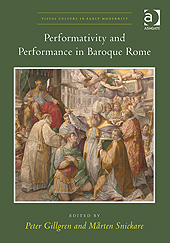
Abstract:
A new interest in the study of early modern ritual, ceremony, formations of personal and collective identities, social roles, and the production of meaning inside and outside the arts have made it possible to talk today about a performative turn in the humanities. In Performativity and Performance in Baroque Rome, scholars from different fields of research explore performative aspects of Baroque culture. With examples from the politics of diplomacy and everyday life, from theatre, music and ritual as well as from architecture, painting and sculpture the contributors demonstrate how broadly the concept of performativity has been adopted within different disciplines.
Contents include:
Introduction: by the tomb of St Genesius, Peter Gillgren and Mårten Snickare; Part I A Performative Society: Varieties of performance in 17th-century Italy, Peter Burke; Diplomatic performances and the applied arts in 17th-century Europe, Martin Olin; CorpoReality: Queen Christina of Sweden and the embodiment of sovereignty, Camilla Kandare; How to do things with the piazza San Pietro: performativity and baroque architecture, Mårten Snickare. Part II Performances and Audiences: Transforming spectators into viri perculsi: Baroque theatre as machinery for producing affects, Erika Fischer-Lichte; Angels or sirens? Questions of performance and reception in Roman church music around 1650, Lars Berglund; The Quarant 'Ore: early modern ritual and performativity, Nils Holger Petersen. Part III Performativity and Interpretation: Allegories of Eros: Caravaggio's masque, Genevieve Warwick; Una dolcissima estasi: performing The Visitation by Frederico Barocci, Peter Gillgren; The apparition of faith: the performative meaning of Gian Lorenzo Bernini's decoration for the Cornaro chapel, Margarethe Rossholm Lagerlöf; Performativity in Michelangelo's Last Judgment, Giovanni Careri. Part IV Postscript: Baroque rhetoric: the methodology, David Carrier; Bibliography; Index.
Details:
Editors: Peter Gillgren and Mårten Snickare
Title: Performativity and Performance in Baroque Rome
Publisher: Ashgate
Date: April 2012
Place of publication: United Kingdom
ISBN: 978-1-4094-2099-6
Shakespeare's Festive Comedy: A Study of Dramatic Form and Its Relation to Social Custom
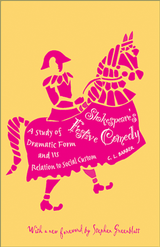
Abstract:
In this classic work, acclaimed Shakespeare critic C. L. Barber argues that Elizabethan seasonal festivals such as May Day and Twelfth Night are the key to understanding Shakespeare's comedies. Brilliantly interweaving anthropology, social history, and literary criticism, Barber traces the inward journey--psychological, bodily, spiritual--of the comedies: from confusion, raucous laughter, aching desire, and aggression, to harmony. Revealing the interplay between social custom and dramatic form, the book shows how the Elizabethan antithesis between everyday and holiday comes to life in the comedies' combination of seriousness and levity.
This new edition includes a foreword by Stephen Greenblatt, who discusses Barber's influence on later scholars and the recent critical disagreements that Barber has inspired, showing that Shakespeare's Festive Comedy is as vital today as when it was originally published.
This edition is also available in E-Book format.
Review:
'Well-considered, subtly thought-out commentaries that move easily between structural analysis of the larger actions and sensitive dissection of local textures . . . a first-rate work of impressive imagination.' - Modern Philology
'Shakespeare's Festive Comedy is the best book on the subject that I know. The book is well and clearly written, and I should think would fascinate the general readers. I think it is indispensable for students of Shakespeare's comedy.' - Francis Fergusson
'I can think of no other book that has had such a powerful influence on the ways in which Shakespeare has been taught over the past thirty years. Shakespeare's Festive Comedy was a book ahead of its time. Barber revolutionized the ways that Shakespeareans thought of comedy in relation to its social setting--especially festive comedy. Others have built on his argument but nobody has really improved on his keen, central insight.' - James Shapiro, Columbia University
Details:
Author: C. L. Barber
Title: Shakespeare's Festive Comedy: A Study of Dramatic Form and Its Relation to Social Custom
Publisher: Princeton University Press
Date: October 2011 (E-Book) and November 2011 (Paperback)
Place of publication: United Kingdom
ISBN: 9781400839858 (E-Book) and 9780691149523 (Paperback)
Representations of Elizabeth I in Early Modern Culture
Abstract:
This volume explores Elizabeth I's influence on English and European culture through her own writing (including manuscripts and literary and non-literary productions) in her time and in the decades following her death, as well as through the representation of contemporary and later writers. Elizabeth I united in herself a variety of roles: woman and queen, 'mother' of her people and stern ruler, and writer and recipient of some of the most important writings of the age. The very complexity of her personality requires a multidisciplinary approach. With contributions from codicologists, historians and literary critics, this volume offers a varied reading of the queen and of her cultural inheritance. The book is thus a precious tool for anyone approaching Elizabeth as politician, poet or literary persona.
Contents include:
Introduction: 'A monarch in writing', A.Petrina; Prologue: 'I am Richard the Second', S.Orgel; PART I: THE WORD OF A PRINCE: ELIZABETH WRITING; The Queen's two hands, J.Gibson; Mary Stuart's Execution and Queen Elizabeth's Divided Self, P.Baseotto; 'Ma plume vous pourra exprimer': Elizabeth's French Correspondance, G.Coatalen; 'Most peereles Poëtresse': The Manuscript Circulation of Elizabeth's Poems, C.Bajetta; PART II: WE PRINCES ARE SET ON STAGES: MASQUES AND CEREMONIES OF ROYAL SELF-DISPLAY; The Monarch as Represented in the Ceremony of Coronation, J.Dillon; Elizabeth's Presence in the Jacobean Masque, E.Botonaki; Lady of the Lake or Queen of the Ocean? The Representation of Female Power in Prince Henry's Barriers and Tethys' Festival, S.Trevisan; PART III: IN MIRRORS MORE THAN ONE: ELIZABETH AND REPRESENTATIONS OF FEMALE SOVEREIGNTY; Performing the Apocalypse: Sibylline Prophecy and Elizabeth I, J.L.Malay; Under Italian eyes: Petruccio Ubaldini's Verbal Portraits of Queen Elizabeth, G.Iamartino; Never a Merry World: The Rhetoric of Nostalgia in Elizabethan England, K.Johanson; No Country for Old Women?, Y.Oram; 'A queen in jest': Queenship and Historical Subversion in Shakespeare's 3 Henry VI and Richard III, K.Mudan; Mirrors for Female Rulers: Elizabeth I and the Duchess of Malfi, L.Tosi
Reviews:
'This new essay collection makes a serious and significant contribution to studies of Elizabeth I. A diversity of approaches sheds new light on this iconic queen, investigating the materiality of her own writings as well as her influence on stagings of female power. We are invited to view her from perspectives of prophecy and nostalgia, and to look afresh at this endlessly fascinating monarch.'
- Helen Hackett, University College London, UK
'This considered and cohesive sequence of essays on the cultural presence of Elizabeth I is both elegant and timely. The collection is given a distinguished focus in the Prologue contributed by the celebrated expert on Elizabethan culture and drama, Stephen Orgel, with its poised consideration of the relation between the arts and the 'monarch's will.' Thereafter, the book's three sections explore the image and presence of the queen: in her own words, in the events and writings which she promoted and patronised, and in subsequent recollection and reinterpretation.
The focus throughout is international with significant work on Elizabeth's use of French and on Elizabeth's appearance in the eyes of an Italian contemporary. Her place in time is considered in many aspects: as a figure embodying past virtues, as the presiding goddess of a glorious present, and as the prophetess of a new order to come. One of the distinguishing features of this collection is the awareness which accompanies all these investigations of the elements of improvisation and insecurity which formed the counterpoint to the public triumphs of Elizabeth. There are particularly rich reflections on dramatic echoes of Elizabeth's governance in the plays of Webster and Shakespeare.
The continental focus of the volume is particularly welcome, offering the reader new discoveries on the map of the queen's world. This focus also points silently to a palpable absence of Elizabethan culture: the ambiguous withdrawal of her realm from the international respublica litterarum, from the possibility of comparison.
This collection is as notable for the careful selection of subjects and editorial shaping of a coherent whole as it is for the skill and knowledge of the individual contributors. The Introduction draws the whole volume together in its finely-nuanced consideration of Elizabeth as a subject placed in time.'
- Peter Davidson, Professor of Renaissance Studies, University of Aberdeen, UK
Details:
Editors: Alessandra Petrina and Laura Tosi
Title: Representations of Elizabeth I in Ealry Modern Europe
Publisher: Palgrave Macmillan
Date: April 2011
Place of publication: United Kingdom
ISBN: 9780230278172
Representing the king's splendour: Communication and reception of symbolic forms of power in Viceregal Naples
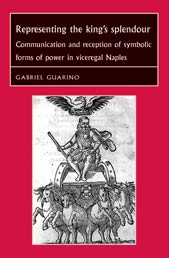
Abstract
Compensating for the general neglect of Iberian civilization in southern Italy, this book seeks to shed light on the viceregal court of Spanish Naples in the seventeenth century, at a time when this European metropolis reached the zenith of its splendour. The author looks at the cultural projection of Spain and its values, either via the direct visual representations of power of the viceregal court, or the public policies and actions that fostered Spanish attitudes. It explores cultural and social manifestations as court ceremonial, state festivities, and fashion.
Aimed at students and scholars of early modern Europe, the Spanish Empire, and the princely courts of Europe, this study will also be of interest to scholars of communication and cultural studies, and to readers interested in cultural history during the Baroque era.
Contents include:
* The ritual power of viceroys * The viceregal institution * Court ceremonial * The viceregal public image * The power of precedence: social and political hierarchies of civic processions * The hierarchical structure of cavalcades in early modern Naples * Extraordinary cavalcades and conflicts of precedence * State celebrations * The festive system of early modern Naples * Management, patronage, and reception of civic celebrations * Spanish tournaments in Neapolitan state festivities * Spanish fashion and the governance of appearances in viceregal Naples * Regulating appearances: Spanish fashion and the Catholic Reformation, 1517-1648 * Successes and limitations of Spanish fashion * Governing appearances and luxury * Political utilisation of imprese in viceregal Naples * The uses of imprese in tournaments * Neapolitan imprese for the obsequies of the Habsburg monarchs
Details
Author: Gabriel Guarino
Title: Representing the king's splendour: Communication and reception of symbolic forms of power in Viceregal Naples
Publisher: Manchester University Press
Date: March 2011
Place of publication: Manchester
ISBN: 978-0-7190-7822-4
El Legado de Borgona: Fiesta y Ceremonia Cortesana en la Europa de los Austrias
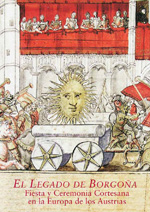
Abstract
At the close of the fifteenth century a courtly etiquette prevailed in the court of the Dukes of Burgundy together with a manner of observance and representation which achieved great influence on many of the European courts, thanks to close ties with the House of Habsburg.
This collection analyses from a new perspective the presence and adaptation of Flemish-Burgundian traditions in the festivals and occasional and established ceremonies of chivalric culture including the Order of the Golden Fleece, resulting in the formation of a fitting dynastic trdition, commencing with the extraordinary banquet of the Votos del Faisan celebrated in Lille in 1454 and continuing up to the middle years of the seventeenth century.
Details:
Editors: Krista De Jonge, Bernardo J. Garcia Garcia and Alicia Esteban Estringana
Title: El Legado de Brogona: Fiesta y Ceremonia Cortesana en la Europa de los Austrias
Publisher: Marcial Pons Ediciones de Historia
Date: 2010
Place of publication: Madrid, Spain
ISBN: 978-84-87369-64-3 and 978-84-92820-24-5
Dramaturgia Festiva y Cultura Nobiliaria en el Siglo de Oro
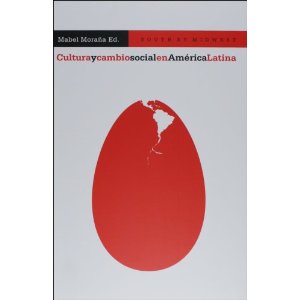
Abstract:
This collection of essays features a wide-ranging reserach programme dealing with the Court and courtly society in the Early Modern period in Europe, drawing on the work of different specialists and research methodologies. The volume links to the earlier La fiesta cortesana en la epoca de los Austrias (2003). The new research relates to investigations into the culture of the nobility in their relationships to the authority of the Court, limited on this occasion to festival drama in Spain in the period of the late sixteenth and early seventeenth centuries.
Details:
Editors: Bernardo J Garcia and Maria Luisa Lobato
Title: Dramaturgia Festiva y Cultura Nobiliaria en el Siglo de Oro
Publisher: Ibermamericana (Madrid) and Vervuert (Frankfurt-am-Main)
Date: 2007
Place of publication: Spain and Germany
ISBN: 978-84-8489-294-6 (Spain) and 978-3-86527-325-3 (Germany)
Dans l'atelier des Menus Plaisirs du roi: spectacles, fêtes et cérémonies aux XVIIe et XVIIIe siècles
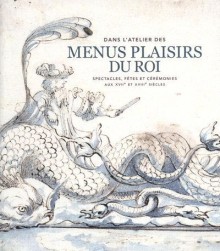
Abstract
Exhibition Catalogue "Dans l'atelier des Menus Plaisirs du roi" presented by the Archives nationales at the Hôtel de Soubise, Paris (19 January - 24 April 2011)
This is a selection of over 100 graphic works, largely unedited, from the fonds of the Maison du Roi in the Archives nationales in France. They have been conserved by the Menu Plaisirs du roi since its creation in 1752 as a body intended to realise artistically and scientifically, as well as to finance, the spectacles demanded by the monarchy in this period. The content of the book highlights the marvellous nature of various court ceremonies in the seventeenth and eighteenth centuries, as well as providing detailed information on the archival locations of interesting and important festival sources. Spectacles addressed in the book include royal entries, state funerals, operas, firework celebrations and outdoor magnificences. A dozen related sources, found in Paris, Versailles, Berlin, London, Vienna and Stockholm, have also been added; all examples have been chosen for their artistic quality, their historical interest and their scientific value.
Details:
Author(s): Jérôme de La Gorce, Pierre Jugie et al
Title: Dans l'atelier des Menus Plaisirs du roi: spectacles, fêtes et cérémonies aux XVIIe et XVIIIe siècles [in the French]
Publisher: Archives nationales
Date: January 2011
Place of Publication: France
ISBN-EAN13 : 9782854954395
The Correspondence of Elizabeth Stuart, Queen of Bohemia, Volume II
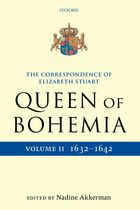
Abstract:
The Letters of Elizabeth Stuart, Queen of Bohemia is the first edition, in three volumes, of Elizabeth Stuart's complete letters ever published. Elizabeth Stuart (1596-1662), also known as Electress Palatine of the Rhine or Queen of Bohemia, was the daughter of King James VI & I and Anna of Denmark, and a key religious, political, and cultural figure in early modern Europe. Volume II, tracing the years between 1632 and 1642, covers Elizabeth's life as a widow controlling the regency during her eldest son's minority and imprisonment. It opens with her husband Frederick V's departure from their court-in-exile in The Hague to the battlefield in Germany, and his unexpected death from the plague in Mainz a few days before Elizabeth and he would have regained the Palatinate. Elizabeth is forced to take Palatine affairs firmly into her own hands as the restitution slips away from her. Her brother King Charles I tries to lure her back to the British Isles, apparently in order to pacify her, but Elizabeth chooses a life of voluntary exile to expedite the restitution.
In this most political period of her life, Elizabeth devises, often unsuccessfully, ploys to gain financial, moral, and military support for the Palatine cause, frequently in direct opposition to her brother's wishes and demands. Her letters were the principal means by which she could exert her power on statesmen and military leaders, such as Archbishop Laud, Charles I, Christian IV of Denmark, the Swedish chancellor Axel Oxenstierna, Cardinal Richelieu of France, and Wladislaw IV of Poland. Elizabeth's eldest son Charles Louis, set free by the French in April 1641, ultimately took over the regency of the Palatine government in November 1642. Elizabeth at this point jadedly relinquished her role as stateswoman.
Reviews:
Contents include:
- Keys to seven cipher codes which decode the letters for the first time
- Extensive cross referencing in footnotes brings out parallels between subjects, letters, or events
- Combined biographical and subject index gives a concise biographical overview of all historical figures mentioned
- Headnotes identify the original manuscript source and draw attention to the social and communicative context of the letters
Details:
Author(s): Nadine Akkerman
Title: The Correspondence of Elizabeth Stuart, Queen of Bohemia, Volume II
Publisher: Oxford University Press
Date: April 2011 (Forthcoming)
Place of Publication: Great Britain
ISBN: 978-0-19-955108-8
The English Renaissance Stage: Geometry, Poetics, and the Practical Spatial Arts 1580-1630

Abstract:
Drawing on entirely new evidence, The English Renaissance Stage: Geometry, Poetics, and the Practical Spatial Arts 1580-1630 examines the history of English dramatic form and its relationship to the mathematics, technology, and early scientific thought during the Renaissance period. The book demonstrates how practical modes of thinking that were typical of the sixteenth century resulted in new genres of plays and a new vocabulary for problems of poetic representation. In the epistemological moment the book recovers, we find new ideas about form and language that would become central to Renaissance literary discourse; in this same moment, too, we find new ways of thinking about the relationship between theory and practice that are typical of modernity, new attitudes towards spatial representation, and a new interest in both poetics and mathematics as distinctive ways of producing knowledge about the world. By emphasizing the importance of theatrical performance, the book engages with continuing debates over the cultural function of the early modern stage and with scholarship on the status of modern authorship. When we consider playwrights in relation to the theatre rather than the printed book, they appear less as 'authors' than as figures whose social position and epistemological presuppositions were very similar to the craftsmen, surveyors, and engineers who began to flourish during the sixteenth century and whose mathematical knowledge made them increasingly sought after by men of wealth and power.
Reviews:
|
Contents include:
|
Details:
Author(s): Henry S. Turner
Title: The English Renaissance Stage: Geometry, Poetics, and the Practical Spatial Arts 1580-1630
Publisher: Oxford University Press
Date: November 2010
Place of Publication: Great Britain
ISBN: 978-0-19-928738-3
Reading Masques: The English Masque and Public Culture in the Seventeenth Century

Abstract:
The first study to consider masques from the point of view of reception as well as production, Reading Masques illuminates intersections of elite and public culture in seventeenth-century England. Court masques, the rhetorically slight but visually and aurally spectacular dramas that framed hours of festive dancing at the English courts of James I and Charles I, were major social occasions for the aristocratic audiences who participated in them, and they have been central to historical and literary considerations of the era's elite culture. However, masques were also undertaken in a far wider range of guises, venues, and decades than has previously been considered. Masques were engaged not only through performance, but also as written texts, through oral report, and adapted as plays, newsbooks, ballads, and operas. Lauren Shohet traces the ways that both courtly and non-courtly masques circulated, connects arenas of performance and print, and rethinks what it means to "read" a masque. Expanding our current understanding of the genre, she draws familiar masques by Jonson, Milton, Davenant, and Shirley together with both lesser known masques and better known plays. The study interweaves analysis of text, music, and spectacle with research into the printing, marketing, and readership of masques, demonstrating the form's importance beyond the social and historical parameters of other studies. Masques' participation in emergent news culture, public theatre, and pamphlet debate reveals the masque's wide significance not only in the Stuart era, but also during the Interregnum, the Restoration, and beyond. As early opera, masques adapted and carried forward Shakespeare and other Tudor-Stuart dramatists, proving central for the construction of a national dramatic canon.
Contents include:
|
